Spiral

In mathematics, a spiral is a curve which emanates from a point, moving farther away as it revolves around the point.
Spirals and helices
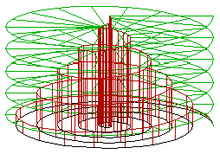
Two major definitions of "spiral" in a respected American dictionary are:[1]
- a. A curve on a plane that winds around a fixed center point at a continuously increasing or decreasing distance from the point.
b. A three-dimensional curve that turns around an axis at a constant or continuously varying distance while moving parallel to the axis; a helix.
Definition a describes a planar curve, that extends in both of the perpendicular directions within its plane; the groove on one side of a record closely approximates a plane spiral (and it is by the finite width and depth of the groove, but not by the wider spacing between than within tracks, that it falls short of being a perfect example); note that successive loops differ in diameter. In another example, the "center lines" of the arms of a spiral galaxy trace logarithmic spirals.
Definition b includes two kinds of 3-dimensional relatives of spirals:
- A conical or volute spring (including the spring used to hold and make contact with the negative terminals of AA or AAA batteries in remote controls), and the vortex that is created when water is draining in a sink is often described as a spiral, or as a conic helix.
- Quite explicitly, b also includes a cylindrical coil spring and a strand of DNA, both of which are quite helical, so that "helix" is a more useful description than "spiral" for each of them; in general, "spiral" is seldom applied if successive "loops" of a curve have the same diameter.[1]
In the side picture, the black curve at the bottom is an Archimedean spiral, while the green curve is a helix. The curve shown in red is a conic helix.
Two-dimensional spirals
A two-dimensional spiral may be described most easily using polar coordinates, where the radius r is a monotonic continuous function of angle θ. The circle would be regarded as a degenerate case (the function not being strictly monotonic, but rather constant).
Some of the most important sorts of two-dimensional spirals include:
- The Archimedean spiral: (see also:Involute)
- The Euler spiral, Cornu spiral or clothoid
- Fermat's spiral:
- The hyperbolic spiral:
- The lituus:
- The logarithmic spiral: ; approximations of this are found in nature
- The Fibonacci spiral and golden spiral: special cases of the logarithmic spiral
- The Spiral of Theodorus: an approximation of the Archimedean spiral composed of contiguous right triangles
- The involute of a circle, used twice on each tooth of almost every modern gear
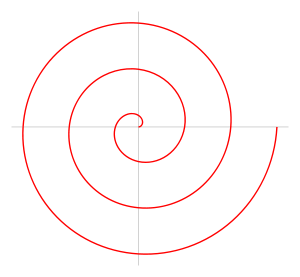 Archimedean spiral
Archimedean spiral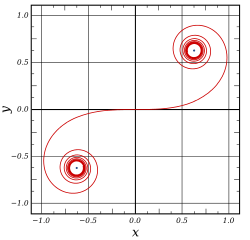 Cornu spiral
Cornu spiral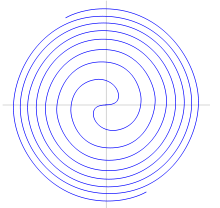 Fermat's spiral
Fermat's spiral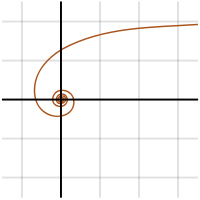 hyperbolic spiral
hyperbolic spiral lituus
lituus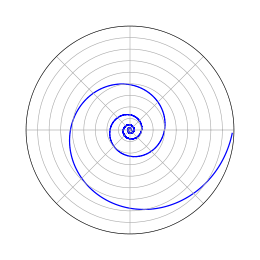 logarithmic spiral
logarithmic spiral spiral of Theodorus
spiral of Theodorus Fibonacci Spiral (golden spiral)
Fibonacci Spiral (golden spiral) The involute of a circle (black) is not identical to the Archimedean spiral (red).
The involute of a circle (black) is not identical to the Archimedean spiral (red).
Three-dimensional spirals
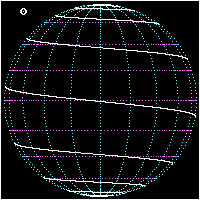

For simple 3-d spirals, a third variable, h (height), is also a continuous, monotonic function of θ. For example, a conic helix may be defined as a spiral on a conic surface, with the distance to the apex an exponential function of θ.
The helix and vortex can be viewed as a kind of three-dimensional spiral.
For a helix with thickness, see spring (math).
A rhumb line (also known as a loxodrome or "spherical spiral") is the curve on a sphere traced by a ship with constant bearing (e.g., travelling from one pole to the other while keeping a fixed angle with respect to the meridians). The loxodrome has an infinite number of revolutions, with the separation between them decreasing as the curve approaches either of the poles, unlike an Archimedean spiral which maintains uniform line-spacing regardless of radius.
In nature
The study of spirals in nature has a long history. Christopher Wren observed that many shells form a logarithmic spiral; Jan Swammerdam observed the common mathematical characteristics of a wide range of shells from Helix to Spirula; and Henry Nottidge Moseley described the mathematics of univalve shells. D’Arcy Wentworth Thompson's On Growth and Form gives extensive treatment to these spirals. He describes how shells are formed by rotating a closed curve around a fixed axis, the shape of the curve remains fixed but its size grows in a geometric progression. In some shell such as Nautilus and ammonites the generating curve revolves in a plane perpendicular to the axis and the shell will form a planar discoid shape. In others it follows a skew path forming a helico-spiral pattern. Thompson also studied spirals occurring in horns, teeth, claws and plants.[2]
A model for the pattern of florets in the head of a sunflower was proposed by H Vogel. This has the form
where n is the index number of the floret and c is a constant scaling factor, and is a form of Fermat's spiral. The angle 137.5° is the golden angle which is related to the golden ratio and gives a close packing of florets.[3]
Spirals in plants and animals are frequently described as whorls. This is also the name given to spiral shaped fingerprints.
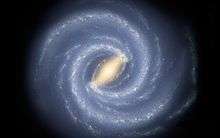 The center Galaxy of Cat's Eye Nebula
The center Galaxy of Cat's Eye Nebula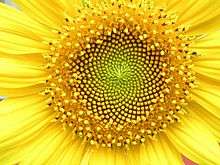 Sunflower head displaying florets in spirals of 34 and 55 around the outside.
Sunflower head displaying florets in spirals of 34 and 55 around the outside.
As a symbol
A spiral like form has been found in Mezine, Ukraine, as part of a decorative object dated to 10,000 BCE.
A Chalcolithic deposit on the West Slope of the Athenian Acropolis. In 1965, during the rearrangement of an area west of the Beulé Gate, on the westslope of the Athenian Acropolis, a well containing prehistoric pottery was uncovered, it was dug entirely out of the bedrock with a diameter of 1.10 m and total depth of 4.10 m. According to the archaeological report by Nikolas Platon and our study of the finds, the deposit contained soil with sporadic small stones, animal bones, some seashells, one obsidian fragment, two grindstones, a spindle whorl made from a sherd, and pottery sherds (a total of 416), including four complete vessels. During restoration work, eight further whole vessels were reassembled. The spirals are an obvious feature on the reassembled vessels, thus placing the origin and the earliest date in the Final Neolithic era also called Chalcolithic, 4500–3200 BC.[4]
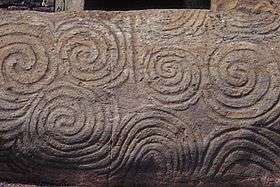
The spiral and triple spiral motif is a Neolithic symbol in Europe (Megalithic Temples of Malta). The Celtic symbol the triple spiral is in fact a pre-Celtic symbol.[5] It is carved into the rock of a stone lozenge near the main entrance of the prehistoric Newgrange monument in County Meath, Ireland. Newgrange was built around 3200 BCE predating the Celts and the triple spirals were carved at least 2,500 years before the Celts reached Ireland but has long since been incorporated into Celtic culture.[6][6] The triskelion symbol, consisting of three interlocked spirals or three bent human legs, appears in many early cultures, including Mycenaean vessels, on coinage in Lycia, on staters of Pamphylia (at Aspendos, 370–333 BC) and Pisidia, as well as on the heraldic emblem on warriors' shields depicted on Greek pottery.[7]
Spirals can be found throughout pre-Columbian art in Latin and Central America. The more than 1,400 petroglyphs (rock engravings) in Las Plazuelas, Guanajuato Mexico, dating 750-1200 AD, predominantly depict spirals, dot figures and scale models.[8] In Colombia monkeys, frog and lizard like figures depicted in petroglyphs or as gold offering figures frequently includes spirals, for example on the palms of hands.[9] In Lower Central America spirals along with circles, wavy lines, crosses and points are universal petroglyphs characters.[10] Spirals can also be found among the Nazca Lines in the coastal desert of Peru, dating from 200 BC to 500 AD. The geoglyphs number in the thousands and depict animals, plants and geometric motifs, including spirals.[11]
Spiral shapes, including the swastika, triskele, etc., have often been interpreted as solar symbols. Roof tiles dating back to the Tang Dynasty with this symbol have been found west of the ancient city of Chang'an (modern-day Xian).
Spirals are also a symbol of hypnosis, stemming from the cliché of people and cartoon characters being hypnotized by staring into a spinning spiral (one example being Kaa in Disney's The Jungle Book). They are also used as a symbol of dizziness, where the eyes of a cartoon character, especially in anime and manga, will turn into spirals to show they are dizzy or dazed. The spiral is also found in structures as small as the double helix of DNA and as large as a galaxy. Because of this frequent natural occurrence, the spiral is the official symbol of the World Pantheist Movement.[12] The spiral is also a symbol of the dialectic process and Dialectical monism.
In art
The spiral has inspired artists throughout the ages. Among the most famous of spiral-inspired art is Robert Smithson's earthwork, "Spiral Jetty", at the Great Salt Lake in Utah.[13] The spiral theme is also present in David Wood's Spiral Resonance Field at the Balloon Museum in Albuquerque, as well as in the critically acclaimed Nine Inch Nails 1994 concept album The Downward Spiral. The Spiral is also a prominent theme in the anime Gurren Lagann, where it represents a philosophy and way of life. It also central in Mario Merz and Andy Goldsworthy's work.
See also
- Megalithic Temples of Malta
- Hypogeum of Ħal-Saflieni
- Celtic maze (straight-line spiral)
- Fibonacci number
- Patterns in nature
- Seashell surface
- Spirangle
- Spiral vegetable slicer
- Stairs
- Triskelion
References
- 1 2 "Spiral", The American Heritage Dictionary of the English Language, Houghton Mifflin Company, Fourth Edition, 2009.
- ↑ Thompson, D'Arcy (1942) [1917]. "On Growth and Form".
- ↑ Prusinkiewicz, Przemyslaw; Lindenmayer, Aristid (1990). The Algorithmic Beauty of Plants. Springer-Verlag. pp. 101–107. ISBN 978-0-387-97297-8.
- ↑ "Attica and the Cyclades from the Chalcolithic to the Early Bronze Age | Konstantinos Zachos". Academia.edu. 1970-01-01. Retrieved 2016-11-12.
- ↑ Anthony Murphy and Richard Moore, Island of the Setting Sun: In Search of Ireland's Ancient Astronomers, 2nd ed., Dublin: The Liffey Press, 2008, pp. 168-169
- 1 2 "Newgrange Ireland - Megalithic Passage Tomb - World Heritage Site". Knowth.com. 2007-12-21. Retrieved 2013-08-16.
- ↑ For example, the trislele on Achilles' round shield on an Attic late sixth-century hydria at the Boston Museum of Fine Arts, illustrated in John Boardman, Jasper Griffin and Oswyn Murray, Greece and the Hellenistic World (Oxford History of the Classical World) vol. I (1988), p. 50.
- ↑ "Rock Art Of Latin America & The Caribbean" (PDF). International Council on Monuments & Sites. June 2006. p. 5. Retrieved 4 January 2014.
- ↑ "Rock Art Of Latin America & The Caribbean" (PDF). International Council on Monuments & Sites. June 2006. p. 99. Retrieved 4 January 2014.
- ↑ "Rock Art Of Latin America & The Caribbean" (PDF). International Council on Monuments & Sites. June 2006. p. 17. Retrieved 4 January 2014.
- ↑ Jarus, Owen (14 August 2012). "Nazca Lines: Mysterious Geoglyphs in Peru". LiveScience. Retrieved 4 January 2014.
- ↑ Harrison, Paul. "Pantheist Art" (PDF). World Pantheist Movement. Retrieved 7 June 2012.
- ↑ Israel, Nico (2015), Spirals : the whirled image in twentieth-century literature and art, New York Columbia University Press, pp. 161–186, ISBN 978-0-231-15302-7
Related publications
- Cook, T., 1903. Spirals in nature and art. Nature 68 (1761), 296.
- Cook, T., 1979. The curves of life. Dover, New York.
- Habib, Z., Sakai, M., 2005. Spiral transition curves and their applications. Scientiae Mathematicae Japonicae 61 (2), 195 – 206.
- Dimulyo, S., Habib, Z., Sakai, M., 2009. Fair cubic transition between two circles with one circle inside or tangent to the other. Numerical Algorithms 51, 461–476 .
- Harary, G., Tal, A., 2011. The natural 3D spiral. Computer Graphics Forum 30 (2), 237 – 246 .
- Xu, L., Mould, D., 2009. Magnetic curves: curvature-controlled aesthetic curves using magnetic fields. In: Deussen, O., Hall, P. (Eds.), Computational Aesthetics in Graphics, Visualization, and Imaging. The Eurographics Association .
- Wang, Y., Zhao, B., Zhang, L., Xu, J., Wang, K., Wang, S., 2004. Designing fair curves using monotone curvature pieces. Computer Aided Geometric Design 21 (5), 515–527 .
- A. Kurnosenko. Applying inversion to construct planar, rational spirals that satisfy two-point G2 Hermite data. Computer Aided Geometric Design, 27(3), 262–280, 2010 .
- A. Kurnosenko. Two-point G2 Hermite interpolation with spirals by inversion of hyperbola. Computer Aided Geometric Design, 27(6), 474–481, 2010.
- Miura, K.T., 2006. A general equation of aesthetic curves and its self-affinity. Computer-Aided Design and Applications 3 (1–4), 457–464 .
- Miura, K., Sone, J., Yamashita, A., Kaneko, T., 2005. Derivation of a general formula of aesthetic curves. In: 8th International Conference on Humans and Computers (HC2005). Aizu-Wakamutsu, Japan, pp. 166 – 171 .
- Meek, D., Walton, D., 1989. The use of Cornu spirals in drawing planar curves of controlled curvature. Journal of Computational and Applied Mathematics 25 (1), 69–78 .
- Farin, G., 2006. Class A Bézier curves. Computer Aided Geometric Design 23 (7), 573–581 .
- Farouki, R.T., 1997. Pythagorean-hodograph quintic transition curves of monotone curvature. Computer-Aided Design 29 (9), 601–606.
- Yoshida, N., Saito, T., 2006. Interactive aesthetic curve segments. The Visual Computer 22 (9), 896–905 .
- Yoshida, N., Saito, T., 2007. Quasi-aesthetic curves in rational cubic Bézier forms. Computer-Aided Design and Applications 4 (9–10), 477–486 .
- Ziatdinov, R., Yoshida, N., Kim, T., 2012. Analytic parametric equations of log-aesthetic curves in terms of incomplete gamma functions. Computer Aided Geometric Design 29 (2), 129 – 140 .
- Ziatdinov, R., Yoshida, N., Kim, T., 2012. Fitting G2 multispiral transition curve joining two straight lines, Computer-Aided Design 44(6), 591–596 .
- Ziatdinov, R., 2012. Family of superspirals with completely monotonic curvature given in terms of Gauss hypergeometric function. Computer Aided Geometric Design 29(7): 510–518 .
- Ziatdinov, R., Miura K.T., 2012. On the Variety of Planar Spirals and Their Applications in Computer Aided Design. European Researcher 27(8–2), 1227-–1232 .
External links
| Wikimedia Commons has media related to Spiral. |
- SpiralZoom.com, an educational website about the science of pattern formation, spirals in nature, and spirals in the mythic imagination.
- Spirals by Jürgen Köller
- Spirals – an Encyclopedia of Life collection with examples of spirals in nature.
- Archimedes' spiral transforms into Galileo's spiral. Mikhail Gaichenkov, OEIS
- Educational webpage connecting spirals to nature, art and patterns.
